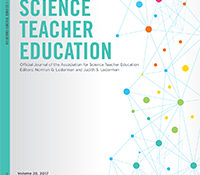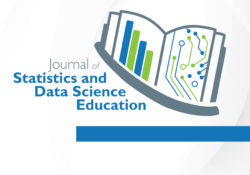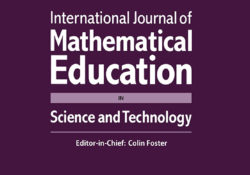tandfonline.com har udgivet en rapport under søgningen “Teacher Education Mathematics”: ABSTRACT ABSTRACT This article presents an ongoing research project, which researches theatre as a school subject at high school level in Sweden. The study is an example of practice-based research on teaching and learning and uses the model learning study for its research approach. It is argued that knowledge concerning the meaning of knowing the object of learning, in this case “to impose one´s will”, is generated using the model. The results are presented as three categories of description and in an outcome space. The categories describe different ways of knowing the object of learning, in this case how to impose one´s will (what the character wants) with the purpose of developing the capability to consciously communicate with an audience.… Continue Reading →
Like this:
Like Loading...

tandfonline.com har udgivet en rapport under søgningen “Teacher Education Mathematics”: ABSTRACT ABSTRACT Science teachers should be able to notice student preconceptions in order to adapt instructions to their students’ needs and support the learning process. Noticing as a core practice of teaching should thus be implemented early in science teacher education. A crucial prerequisite for noticing is knowledge about students’ preconceptions, which is an important element of science teachers’ pedagogical content knowledge. To enhance pre-service teachers’ pedagogical content knowledge, flipped classroom approaches seem especially promising as they combine a theoretical introduction to important didactic concepts with a direct application of these concepts in profession-oriented learning tasks. Furthermore, flipped classrooms seem to satisfy the three basic personal needs of experience in competence, social relatedness, and autonomy according to the self-determination theory… Continue Reading →
Like this:
Like Loading...
tandfonline.com har udgivet en rapport under søgningen “Teacher Education Mathematics”: Abstract Formulae display:?Mathematical formulae have been encoded as MathML and are displayed in this HTML version using MathJax in order to improve their display. Uncheck the box to turn MathJax off. This feature requires Javascript. Click on a formula to zoom. Abstract In the classroom, we traditionally visualize inferential concepts using static graphics or interactive apps. For example, there is a long history of using apps to visualize sampling distributions. The lineup protocol for visual inference is a recent development in statistical graphics that has created an opportunity to build student understanding. Lineups are created by embedding plots of observed data into a field of null (noise) plots. This arrangement facilitates comparison and helps build student intuition about the difference… Continue Reading →
Like this:
Like Loading...
tandfonline.com har udgivet en rapport under søgningen “Teacher Education Mathematics”: Abstract Abstract Using data from 4047 adolescents in three countries, this study was designed to investigate the associations between two important components of the learning process: academic motivation and student engagement. To increase the precision and accuracy of these analyses, preliminary analyses were conducted to identify the optimal measurement structure of both constructs, leading us to retain a bifactor exploratory structural equation modeling representation of academic motivation and of a partial bifactor confirmatory factor analytic representation for student engagement. Our main analyses revealed that academic motivation factors were able to explain almost 66% of the variance in global levels of engagement, and between 5% and 35% of the variance in specific levels of engagement. Finally, mediation analyses supported the role… Continue Reading →
Like this:
Like Loading...
eric.ed.gov har udgivet: This book offers guidelines for elementary school teachers for making adaptations in reading and mathematics instruction for students with mild disabilities in the general education classroom. Following an introductory chapter, Chapter 1 presents eight principles for materials adaption organized according to the acronym FLEXIBLE: F-feasible (adaptations must be feasible in the classroom), L-lively (adaptations must be lively and fun), E-eliminated (adaptations must have the goal of being eventually faded out), X-explicit (adaptations must have a definite explicit purpose), I-intentional (adaptions should be part of a comprehension individualized plan), B-beneficial (adaptations should benefit the student with disabilities without detracting from the learning of other students), L-limelight (adaptations do not place undue attention on the student with disabilities), and E-evaluated (adaptations should be evaluated on an ongoing basis). Chapter… Continue Reading →
Like this:
Like Loading...
eric.ed.gov har udgivet: The Bill and Melinda Gates Foundation has invested in the development and dissemination of high-quality formative assessment tools to support teachers’ incorporation of the Core Common State Standards (CCSS) into their classroom instruction. Lessons from the first generation of standards-based reforms suggest that intense attention to high quality instructional tasks, use of formative assessments embedded in those tasks, and professional development (PD) that attends to both content knowledge and instruction are essential considerations if teachers are to meet the demands of the CCSS. Experts from the Shell Centre have developed a set of formative assessment lessons (FALs) for high school mathematics teachers to facilitate CCSS-based student mathematics learning and provide teachers with feedback about student understanding and mastery. The tools are designed to target the “instructional core”… Continue Reading →
Like this:
Like Loading...
tandfonline.com har udgivet en rapport under søgningen “Teacher Education Mathematics”: Abstract Formulae display:?Mathematical formulae have been encoded as MathML and are displayed in this HTML version using MathJax in order to improve their display. Uncheck the box to turn MathJax off. This feature requires Javascript. Click on a formula to zoom. This paper presents a case study of two sixth-grade students’ use of an iPad as an instructional tool for mathematics. Based on their written and oral responses, we investigated and analyzed their meaning making process with mathematical content in a classroom where the iPad was a central tool for teaching practices. The analyses were based on Steinbring’s [(2005). The construction of new mathematical knowledge in classroom interaction: An epistemological perspective (Vol. 38). Springer] framework, which we applied to understand… Continue Reading →
Like this:
Like Loading...
eric.ed.gov har udgivet: Korean education certainly has its strong points as its fifteen year olds produce outstanding results in the area of mathematics and are the world’s most literate bunch. However, South Korean high schools are insufficiently preparing students for an often learner centered and creative system of education that often necessitates students to be self-motivated, at universities in and out of Korea. Nevertheless, Koreans often make the plea that Korean education is fine and sound at all levels. In essence, they argue that their education is world class and that their high schools are superb while citing PISA (Program for International Student Assessment) 2006 results to support their case. On the other hand, I would state exactly the opposite, for reasons which I have based on both experience and… Continue Reading →
Like this:
Like Loading...
eric.ed.gov har udgivet: The literature suggests there is much to be gained from exploring the role of the peer network in linguistically diverse “mainstream” middle school classrooms (i.e., classrooms that include English language learners alongside fluent English-speakers). The present study uses social network analysis to examine whether between-classroom and between-student variation in cross-language-status integration in the classroom peer network may contribute to between-classroom and between-student differences in learning. Data from a larger mixed-methods study at a linguistically diverse middle school in the southeastern United States are analyzed to test two hypotheses: (1) Classrooms with more linguistically integrated peer networks (i.e., those in which the network of friendships in the classroom is less segregated by ELL status) will show greater growth in classroom mean standardized test scores across the school year;… Continue Reading →
Like this:
Like Loading...
eric.ed.gov har udgivet: This study compared the relative effects of three kindergarten schedules on children’s achievement in reading, writing, and mathematics, and on children’s prosocial classroom behaviors. Participating were 47 children attending all-day kindergarten, 56 attending alternate-day kindergarten, and 44 attending half-day kindergarten. Individual achievement tests were administered in a pretest-posttest procedure. Analysis of covariance showed that the all-day kindergarten group scored significantly higher in reading, with no significant differences in mathematics or writing. Multivariate analysis of covariance for the 14 subscales of classroom social behaviors on the Hahnemann Elementary Behavior Rating Scale showed significant differences between groups, with the half-day children exhibiting higher scores on classroom behaviors that facilitate learning and lower scores on negative behaviors. Possible reasons for these differences and implications of developmentally appropriate practices, teachers’ theoretical… Continue Reading →
Like this:
Like Loading...




